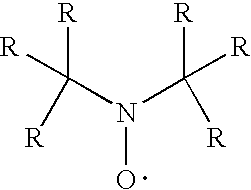Flame retardant compositions
- Summary
- Abstract
- Description
- Claims
- Application Information
AI Technical Summary
Problems solved by technology
Method used
Image
Examples
example 1
[0313] Molding grade polypropylene is dry blended with the test additives and then melt compounded at 425° F. (218° C.). Base stabilization is 500 ppm N,N-di(alkyl)hydroxylamine produced by the direct oxidation of N,N-di(hydrogenated tallow)amine (Irgastab® FS-042) and 500 ppm calcium stearate. Plaques (125 mil) are prepared by injection molding from the formulations using a Boy Injection Molder at 475° F. (246° C.). The specimens are tested for flame retardancy according to the UL-94 vertical burn test specifications. The results are shown below.
[0314] The plaques are tested for flame retardancy by the UL 94V thick section test. The time in seconds for the plaques to extinguish after the insult flame is removed is reported as “After Flame”. The time in seconds that the plaques glow after the flame incurred from the second insult flame is extinguished is reported as “Afterglow”. Efficacy as a flame retardant is demonstrated when low After Flame times are observed relative to a blan...
example 2
[0316] Polyethylene fibers are prepared from fiber grade polyethylene by dry blending with test additives and melt compounding at 400° F. Fibers are extruded from this formulation using a Hills laboratory scale fiber extruder. Socks are knitted from the fibers and are tested for flame retardancy according to NFPA 701 vertical burn method. Polyethylene fibers contain an additive of present components (a)-(j) in combination with a classic brominated flame retardant decabromodiphenyl oxide (DBDPO); bis(2,3-dibromopropyl) ether of tetrabromobis phenol A (PE68); or ethylene bis-tetrabromophthalimide (SAYTEX® BT-93). These formulated fibers are tested for flame retardancy according to NFPA 701.
[0317] The fibers containing both an additive of components (a)-(j) of the present invention and a classic brominated flame retardant exhibit enhanced flame retardancy compared to the classic flame retardant alone.
example 3
[0318] Polyethylene (LDPE) is melt compounded on a twin screw extruder at 450° F. (232° C.) with an additive of present components (a)-(j) in combination with a classic brominated flame retardant decabromodiphenyl oxide (DBDPO); bis(2,3-dibromopropyl) ether of tetrabromobis phenol A (PE68); or ethylene bis-tetrabromophthalimide (SAYTEX® BT-93). 125 mil plaques are compression molded at 400° F. (204° C.).
[0319] The plaques are tested for flame retardancy by the UL 94V thick section test.
[0320] The plaques containing both an additive of components (a)-(j) of the present invention and a classic brominated flame retardant exhibit enhanced flame retardancy compared to the classic flame retardant alone.
PUM
| Property | Measurement | Unit |
|---|---|---|
| Percent by mass | aaaaa | aaaaa |
| Percent by mass | aaaaa | aaaaa |
| Percent by mass | aaaaa | aaaaa |
Abstract
Description
Claims
Application Information
 Login to View More
Login to View More - R&D
- Intellectual Property
- Life Sciences
- Materials
- Tech Scout
- Unparalleled Data Quality
- Higher Quality Content
- 60% Fewer Hallucinations
Browse by: Latest US Patents, China's latest patents, Technical Efficacy Thesaurus, Application Domain, Technology Topic, Popular Technical Reports.
© 2025 PatSnap. All rights reserved.Legal|Privacy policy|Modern Slavery Act Transparency Statement|Sitemap|About US| Contact US: help@patsnap.com



